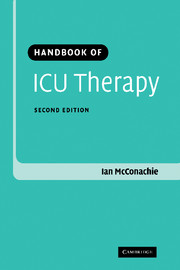Book contents
- Frontmatter
- Contents
- List of contributors
- Preface
- Part I Basic principles
- Part II Specific problems
- 17 The surgical patient in the ICU
- 18 The trauma patient
- 19 Acute coronary syndromes
- 20 Heart failure
- 21 Arrhythmias
- 22 The patient with sepsis
- 23 Acute renal failure in the critically ill
- 24 Acute lung injury and ARDS
- 25 The patient with gastrointestinal problems
- 26 The comatose patient
- 27 The critically ill asthmatic
- 28 The critically ill diabetic
- 29 The cardiac surgical patient in the ICU
- 30 Cardiac arrest
- Index
28 - The critically ill diabetic
Published online by Cambridge University Press: 24 August 2009
- Frontmatter
- Contents
- List of contributors
- Preface
- Part I Basic principles
- Part II Specific problems
- 17 The surgical patient in the ICU
- 18 The trauma patient
- 19 Acute coronary syndromes
- 20 Heart failure
- 21 Arrhythmias
- 22 The patient with sepsis
- 23 Acute renal failure in the critically ill
- 24 Acute lung injury and ARDS
- 25 The patient with gastrointestinal problems
- 26 The comatose patient
- 27 The critically ill asthmatic
- 28 The critically ill diabetic
- 29 The cardiac surgical patient in the ICU
- 30 Cardiac arrest
- Index
Summary
Diabetes is a common medical condition: almost 5% of the population, although a much smaller proportion, are insulin-dependent diabetics. Consideration of diabetes in this text is worthwhile not least due to the important points regarding fluid therapy in diabetic hyperglycaemic coma.
Diabetic coma, the commonest endocrine emergency, falls into three categories:
Hypoglycaemic coma: easy to understand and treat once recognised. Therefore not discussed here.
Diabetic ketoacidosis (DKA).
Hyperosmolar non-ketotic coma.
DKA
DKA is relatively common:
approximately 5% of insulin-dependent diabetic patients per year,
mainly under the age of 40 years but can also affect elderly patients,
said to affect women more than men.
Precipitated by infection in 30%, management errors in 15% but no obvious cause in 40%. Previously undiagnosed diabetes is the cause in 10% of DKA.
The hallmarks of DKA are:
Hyperglycaemia: Lack of insulin causes the increase in blood sugar by decreasing cellular glucose uptake, increasing protein breakdown (thus promoting gluconeogenesis) and glycogenolysis.
Dehydration (5–10 l of water) lost by osmotic diuresis, hyperventilation and vomiting.
Loss of electrolytes, approximately 500 mmol in total of both Na and K.
Acidosis (ketosis and, in later stages, lactic acidosis from tissue hypoperfusion).
Much of the fluid lost, comes from the intracellular space and therefore is relatively hypotonic.
- Type
- Chapter
- Information
- Handbook of ICU Therapy , pp. 392 - 400Publisher: Cambridge University PressPrint publication year: 2006
- 1
- Cited by

